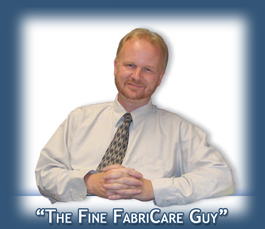Properly Cleaned Upholstery Fabrics Should Be Dry In About An Hour!
Jim Pemberton
Most serious upholstery cleaning problems (browning, bleeding, and shrinkage) are caused, completely or in part, by over-wetting of fabrics.
Upholstery cleaners who avoid over-wetting during cleaning and make certain that fabrics dry quickly afterward have few, if any, damage claims.
Skilled upholstery cleaners have learned to avoid over-wetting by the way that they use their cleaning tools, and by following the cleaning step with a variety of drying procedures. One of the greatest recent innovations in our industry has been the development upholstery "dry tools". These special upholstery tools have the spray either re-directed or contained within the vacuum's airflow to prevent penetration of the cleaning solution through the fabric.
The "Wetting Factor"
The factor OVERLOOKED by most cleaners is the choice of cleaning products based on the penetration or "wetting ability" of that product. Most cleaners assume that upholstery cleaning products are simply "weaker" versions of carpet cleaning products; that is, that they have lower pH readings than the carpet cleaning products that they are more familiar with. This oversimplification causes cleaners to overlook the "wetting factor", which can be just as important as the pH range!
Keep in mind, when you are cleaning upholstery, you are cleaning a fabric that is about as thick as your clothing! Bleeding, browning and shrinkage become far more likely if your cleaning compounds penetrate into the fabric's backing. The aggressive solvent additives and alkaline builders, combined with surfactants that are made for carpet cleaning create a dangerous "one-two punch" that delivers these harsh products under the fabric where unstable dyes, cellulose material, and upholsterer's markings are waiting to be released!
Upholstery cleaning products are formulated differently! In addition to the fact that these products have milder pH ranges, the solvents and surfactants used have a far lower wetting action than carpet cleaning formulations do.
Examples Of Products Used In Upholstery Cleaning:
A. SHAMPOO: A high foam, low wetting shampoo that can be used as either a "stand alone" dry foam product, or as a preconditioner. When applied properly, a shampoo preconditioner will lubricate and suspend embedded soils without wetting out the back of the fabric. NOTE: Keep in mind that preconditioning with a shampoo and following up with a very light rinse designed to prevent over-wetting may leave residues that keep protector from bonding properly!
B. NATURAL FIBER PRECONDITIONERS: These products, such as Natural Fiber Cleaner from Sapphire Scientific, have the low wetting capabilities of a shampoo, and also the low pH status that prevents bleeding and browning, but are far easier to rinse from the fabric when applied in a light mist, or sprayed onto a horsehair preconditioning brush. These products provide the safety of shampoo, but with nearly the effectiveness of higher pH products, and easier rinsing as well.
C. SYNTHETIC FIBER PRECONDITIONERS: Preconditioning agents used to pre-spray synthetic fiber upholstery will have more wetting capability than a shampoo, but should not rapidly wet out a fabric like a carpet traffic lane cleaner. Their pH status may seem to be as alkaline as a traffic lane cleaner, but usually contain weakly buffered solutions that are not as aggressive, and some contain ammonia, which self neutralizes in just a few minutes. As with the Natural Fiber Preconditioners, these products rinse more freely from fabric than both shampoos and traffic lane cleaners, an important quality in restoring textures as well as creating good bonding for protector.
The keys to avoid over-wetting (and subsequent damage claims!) are:
- The Best Tool: Try out the new tools available to our industry, such as the Upholstery Pro from Sapphire Scientific. You'll be surprised at how well they work! -- And how much the labor is reduced!
- The Right Cleaning Agents: Excellent, low wetting preconditioning and cleaning agents are now available.
- The Proper Techniques: There is no tool or cleaning product that can take the place of a well trained technician. Take advantage of the training courses available at the Cleaning Restoration Learning Center. Even if you've taken a class just a few years ago, much has changed, for the better.
